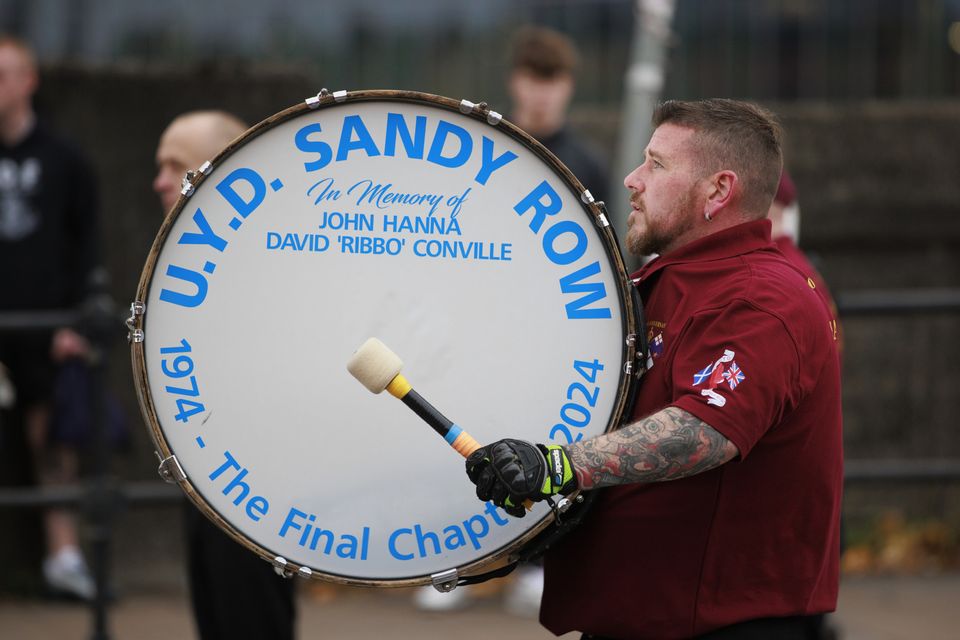A local councillor says it has been an ‘emotional night’ for Sandy Row residents, as members of the Ulster Young Defenders (UYD) Flute Band were the last band to parade over the Boyne Bridge for a final time.
The bridge is set to be removed to make way for a wider regeneration of Belfast’s new Grand Central Station.
The flute band was also marking its 50th anniversary, and marched over the Boyne Bridge from Glengall Street to Sandy Row Rangers Supporters Club to mark the final chapter.
DUP councillor for the area, Tracy Kelly, said it was an “emotional night” as the UYD became the last band to cross the bridge from 6pm on Saturday.
“Fifty years since they were formed, such a lovely tribute from them and Ulster First Flute Band to the community,” she added.
Read more
The Boyne Bridge is to be demolished as part of the Belfast Transport Hub development. The encapsulated 1642 bridge is at the Sandy Row end of the bridge and will remain in situ, as a planning condition.
The railway area beneath the bridge has never been a street or a road, so by demolishing the bridge a new road will be created, linking Durham Street and Sandy Row.
Many locals have pleaded with Translink in the past not to ‘tear it down’ and some have started petitions over the issue.
Members of the Ulster Young Defenders Flute Band mark 50 years as they parade over the Boyne Bridge. Credit: Liam McBurney/RAZORPIX
In August, a parade and rally was held by residents, who demanded that Sandy Row remains “inextricably linked” with the Boyne Bridge.
Residents sought the “direct involvement of Translink in making the application to name the new road Boyne Bridge Place”.
They also called on the NI Housing Executive (NIHE) and Belfast City Council to support them by providing visible structures, artworks and information plaques, and to maintain and promote the name Boyne.
A statement said: “It is also of importance to note that the name Boyne Bridge has been used continually, even long before the reconstructed Boyne Bridge (incorporating the 1642 bridge) was opened in 1936.
“It has been known as the Boyne Bridge for over 160 years. It is therefore most appropriate to name the new road Boyne Bridge Place.
“At a community consultation meeting hosted by Translink on April 5, community representatives expressed the importance of promoting the site because of its historical importance.
“This could be a major asset, not only for the local communities but for those involved in the tourist industry, who should see the potential benefits for the area.
“The buried bridge must be recognised and promoted with the name Boyne Bridge Place, along with an iconic feature like an arch and a plaque showing what the 1642 bridge looked like and general information about the historic site, which has a history going back over 400 years.”
Members of the Ulster Young Defenders Flute Band mark 50 years as they parade over the Boyne Bridge. Credit: Liam McBurney/RAZORPIX
In response, Translink said Belfast Grand Central Station and the surrounding Weavers Cross development is an “exciting transport-led regeneration project” for Belfast, which will increase capacity for bus and rail infrastructure, catering for 20m passengers a year.
“It is vital to transforming the city and enhancing connectivity throughout Northern Ireland and delivering green economic growth,” a spokesperson added.
“We are committed to preserving and celebrating the history and heritage of the area. This includes creating a new public realm and event space, Saltwater Square, with a strong emphasis on arts and culture, which has the potential to become a focal point for everyone to use and enjoy.
“We continue to work with the local community to encapsulate the history and heritage of the local built and natural environment as part of the Weavers Cross development.”

